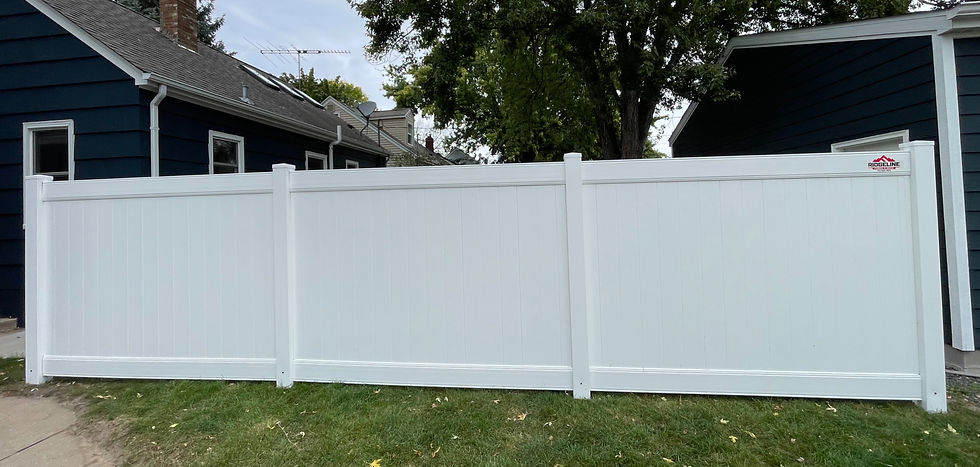Why is My Fence Leaning?
- Maxwell Wiczek
- Nov 13
- 4 min read
When you notice that your fence is starting to lean, it can be more than just an eye-sore. A leaning fence often signals underlying problems that may worsen if left unaddressed. There are several reasons as to why your fence might have started to lean or tilt. More often than not, it is several components working together to cause the damage.

Improper Installation / Shallow Posts
If the fence posts were not installed deeply enough or lacked proper anchoring, the structure will not have the required support. For instance, some posts might not have been buried to a sufficient depth or provided with adequate concrete footings.
Soil Movement, Erosion, or Unstable Ground
The soil surrounding the posts might shift due to water, freeze-thaw cycles, or natural settling.
Weather and Environmental Impacts
Strong winds, heavy rain, snow loads, or even tree roots shifting can apply forces that push the fence out of plumb.
Rot, decay or damage to posts/panels
Especially with wood fences, decay at the base of posts or boards can weaken the structure and allow leaning.
Impacts or external forces
A vehicle bump, tree limb fall, root intrusion, or animals burrowing can all cause a fence to lean.

2. How to Diagnose What’s Causing Your Fence to Lean
To fix the problem correctly, you’ll want to determine why your fence is leaning in your specific situation. Ask and check the following:
Are the posts still firm in the ground, or can you wiggle them?
Is the leaning uniform (the whole section leaning) or only one post/panel?
Has the soil around the posts shifted, washed away, or become softer than before (for example after heavy rain)?
Is there evidence of rot or decay at the base of the posts (especially in wood fences)?
Are there external forces: leaning tree, strong prevailing winds, heavy snow loads, or animals near the fence line?
Was the fence recently installed or repaired (so maybe the issue is from the start)?
Documenting what’s happening will help you decide if you can DIY a fix or need professional help.
3. Step-by-Step Guide to Fixing a Leaning Fence
Here’s a general path you can follow to correct a leaning fence section. (Of course, always check local codes, your warranty, and your fence material.)
Assess the situation: Which posts are affected? How badly is it leaning? Is it safe to continue or could it fall?
Clear around the post(s): Remove debris, plants, or soil that could be interfering. Dig around the post to expose what’s going on underground.
Straighten or replace the post: If the post is still sound, you may be able to re-set it; if rotten or bent, replacement may be best. Use a level to get it plumb.
Re-secure with concrete or proper footing: Pour new concrete or reinforce the footing so the post stays firm. Some DIY methods also include brackets or stakes for reinforcement.
Backfill and grade for drainage: After setting, fill in properly and ensure water won’t pool around the base of the post (which can promote rot or soil softening).
Maintenance and check-up: Periodically check the section, look for signs of movement, rot, or soil shifting. Fix small issues before leaning recurs.

4. Preventing Leaning in the Future
Prevention is much easier (and cheaper) than frequent repairs. Here are some best practices:
Install posts deep enough and anchor them properly (e.g., 2-3 feet deep for many installations) and use good footing.
Choose materials appropriate for your climate (wood treated for moisture, metal posts if high winds, etc).
Ensure proper drainage around posts; avoid water pooling or soft soil near the fence line.
Maintain the fence: treat or seal wood, inspect for rot, replace damaged parts early.
Trim tree branches, control plant growth near the fence, keep large roots from pushing the structure.
Consider reinforcing longer runs or high-wind areas with extra bracing or design features that mask wind impact (like see-through panels).
5. When to Call a Professional
At Ridgeline Fence, we can help with a post replacement! Please note that, in our professional opinion, we strongly recommend and encourage to look at replacing the section of fence if there are more than 3-4 posts that are needing replacement. We have found that it is very common that once there are multiple posts that are needing replacement, you'll inevitably be chasing down repairs for the remainder of the life of the fence.
The leaning fence involves multiple posts or long sections.
The posts are rotten, rusted, or significantly damaged.
The soil conditions are extremely unstable (e.g., heavy clay that expands/contracts, or hillside).
There are complicating factors like property line issues, local code concerns, or you’re unsure of the installation quality.
Safety is at risk (the fence could collapse, injure someone, damage property).
Summary
A leaning fence shouldn’t be ignored. Even a slight tilt is a signal that something is out of alignment, whether it’s the post footing, the ground beneath, material wear, or outside forces. By diagnosing the cause, tackling the repair or reinforcement, and implementing preventive care, you can restore your fence (and keep it upright for years). Plus, a straight, solid fence improves both appearance and performance: it protects your property, defines your space, and gives you peace of mind.




Comments